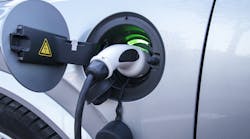The age of electrification is here. Perhaps, more accurately, there is noticeable excitement and momentum surrounding the ongoing development of electric vehicles (EVs). And, growing regulations around lower tailpipe emissions, increasing availability (and announced availability) of attractive options from both start-ups and automotive mainstays, as well as improving battery technology and better economics are collectively fueling the current surge.
“There is a fundamental belief that we are in a transitional period right now. The future will certainly include internal combustion engines (ICE)—although they won't have the same penetration as they enjoy today. And, we will most certainly have EVs,” says Brian Irwin, managing director of Accenture's, automotive, and mobility practice in North America.
Adding to the EV optimism—those consumers on who have already invested in electric vehicles are overwhelmingly impressed with the ICE alternatives. According to the results of J.D. Power’s first U.S. Electric Vehicle Experience Ownership Study, a whopping 95% of EV owners whose overall ownership satisfaction exceeds 900 points say they will purchase another EV with roughly two-thirds (64%) noting that they will repurchase the same brand. However, brand loyalty lessens as satisfaction declines. Specifically, owners whose satisfaction is between 600 and 750 points, 77% indicate they ‘definitely will’ purchase another EV—although their likelihood of repurchasing the same brand is only 25%.”
Is the migration gaining speed?
Admittedly, the migration has been slower than many automotive industry analysts initially projected. Case in point: Experts voiced great expectations that EV market share would reach 20% by 2020. Yet, in reality, consumers were far more hesitant to embark on the migration. However, as Irwin explains, there were a few factors that ultimately impacted the expected trajectory.
“First, the price of fuel was cut in half. Second, and perhaps even more important, the OEMs unilaterally developed means to increase the efficiency of the internal combustion engines,” he says. “Consumers were pleased with improved fuel performance that they were getting in their new vehicle versus their old vehicle. Going forward, there is an expectation that ICE may not be able to achieve the same kind of efficiency improvement or meet the requirements around tailpipe emissions.”
There has long been speculation that when the cost of a kilowatt-hour crossed the $100 threshold, the economics start to work more attractively, explains Irwin. “There are two opposing forces that will absolutely help the cost dimension for EVs. First, technology is improving, and scale and volume are improving such that the cost of battery power will decrease over time. Second, the cost of compliance in an ICE is increasing over time.”
Of course, it is important to note that EVs still only have a small foothold within the US market. Specifically, in the U.S. there is a 2.8% penetration rate for EVs today, although forecasts show it growing as high as 32% by 2030. “This is not a wake up on Tuesday morning, and the world has suddenly changed from ICE to EV,” says Irwin. “There will be there being a migration or adoption over time. As the ecosystem starts to see the take rate on EVs take off, it gives the industry participants, a chance to respond and rethink their portfolio.”
The complexities will understandably ripple back through the tiered supply community. After all, there are fewer front and rear components in the EV than the ICE, and many of those components are quite different (i.e. the electric motor). There are some companies, like Bosch, who make electric motors as well as componentry for ICE vehicles. In these instances, product portfolios will alter as EV adoption or penetration rates increase. At the same time, suppliers solely focused on the componentry associated exclusively to ICE vehicles, such as exhaust systems or fuel management systems, demand rates start to fall over time, but not immediately.
Death of the hybrid?
In its truest form the hybrid serves as the technological bridge between an ICE and the battery EV, explains Irwin. “It serves a great purpose in that it allows both manufacturers and consumers alike to start the migration to more of an electric style vehicle,” he says.
From a pure assembly perspective, assembling an EV is simpler than assembling an ICE. However, the hybrid creates true complexity. “The issue with the hybrid is that you’ve got two fuel systems, you’ve got two propulsion systems, resulting in duplication in some of the major systems. This is where engineering, design, and manufacturing complexity come into play,” he says.
Ultimately, the long-term economics for continued hybrid production do not make sense. “There is solid data around the cost of a kilowatt-hour of power with an EV as well as changes in EV range. If you look at the rate of decline on the cost curve as well as the rate of growth on range for the EV, these two major challenges will be addressed again through a combination of technical advances and scale as more vehicles are put into production and sold,” says Irwin. “Once these challenges are addressed and the need for a hybrid will lessen significantly allowing manufacturers to remove the technical complexity of having two fuel systems and the two propulsion systems. We are not there yet.”
There is still a lot of work, and stars seemingly need to align for EVs to reach the projected 32% market penetration by 2030. For instance, numerous obstacles remain (addressing battery sustainability concerns, creating a broad charging infrastructure, etc.), key players (tradition and start-ups alike) need to stick to their announcements, costs need to continue to drop and technological advances need to continue. Stay tuned for a series of articles addressing each of these aspects over the next few weeks.










